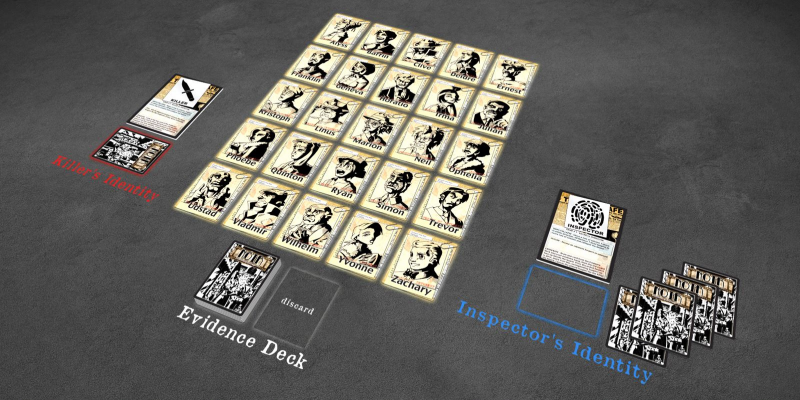
The shady streets and smoky back rooms of detective noir are fertile ground for many a game developer seeking to plunge players into a world of suspense and intrigue. "NOIR: Deductive Mystery" is a distinctive game that embraces the essence of the genre, immersing players in a world of shadowy figures and perplexing puzzles. The title itself promises an experience steeped in the art of deduction, a clarion call to those who fancy themselves amateur sleuths, yearning to don their metaphorical fedora and dive into a labyrinth of crime riddles. In the following journey through the heart of "NOIR: Deductive Mystery," we'll dissect the mechanics of gameplay and the atmospheric embellishments that contribute to the overall experience in hopes of offering a glimpse behind the curtain of this captivating title.
The Intricacies of Gameplay
"NOIR: Deductive Mystery" sets itself apart in the gaming arena with its meticulous dedication to the detective process. At its core, the game is a cerebral chase between the player and the ever-elusive truth. Players adopt the role of a detective, navigating through the murk of deceit and untruths, with only their wits as their guide. They must question suspects, sift through testimonies for potential leads, and piece together the truth from scraps of evidence scattered throughout the game's meticulously designed environment.
The act of revealing the truth is paralleled by a diverse array of puzzles—a smorgasbord of conundrums that challenge the player's logic and attention to detail. From riddles that twist the mind to logic puzzles that test one's deductive capabilities, "NOIR: Deductive Mystery" strikes a delicate balance between challenge and satisfaction, captivating the player as they delve deeper into the heart of the enigma.
Exploring the Shadows: The World of NOIR
NOIR is a collection of engaging games unified by a shared premise and gameplay mechanics. The experience begins with a multitude of suspects arranged in a grid. Each participant is secretly assigned an evidence card that reveals their identity within this grid. Crafted to be succinct, the games last between 5 to 15 minutes and are conveniently packaged in a 54-card deck box, perfect for on-the-go gaming adventures. Players, during their turns, can manipulate the grid by adjusting adjacent cards or artfully "shifting" a row or column, causing a card to cascade out of play and re-enter at the opposite end. Such strategic moves aim to reposition one's character for advantages or to cleverly conceal their whereabouts. With broader investigative actions, players can canvas the grid to deduce if certain characters are nearby.
The Six Engaging Scenarios of NOIR
1. Murderer vs. Inspector (2-player dynamic). One participant systematically eliminates adjacent characters or assumes a new disguise; the other makes accusatory selections of adjacent characters or reviews cards for exoneration. The inspector's goal is to identify the perpetrator, while the adversary works to eliminate the inspector or a set number of innocent individuals.
2. Hitman vs. Sleuth (a duel for two players). In this variation, the assailant has a specific roster of individuals to target.
3. Spy Tag (multiplayer challenge for 3-6 or 8-9 participants). All players are entangled in a cat-and-mouse chase, seeking to capture one another. The first to achieve enough captures claims victory. In larger groups of six or more, teams tally their successful "captures" to determine the winner.
4. Master Thief vs. Chief of Police (2-player engagement). The thief aims to secure treasures in proximity, while the police chief strives to apprehend them in the act.
5. FBI vs. Mafia (team play for 6 or 8 players). With teams equally matched, one faction endeavors to eliminate suspects as the other works diligently to apprehend them. Unique roles across players introduce specialized actions.
6. Heist (team-based for 5-7 players). Thieves collaborate to unlock the secrets of four safes, requiring exceptional teamwork, as the head of security attempts to thwart their efforts. Distinctive abilities assigned to the thieves introduce unique strategies and escalate the level of play over time.
A Reflection on the Game's Appeal
NOIR delights players with its compact yet immersive gameplay. It's the ideal choice for a swift bout of entertainment, filling a brief interlude or serving as the centerpiece of a game night with its more elaborate scenarios. The game caters to a diverse range of players, particularly those with an affinity for deduction and strategy, ensuring that there's something enthralling for everyone who delves into its enigmatic world.
A Sonic and Visual Feast
Complementing the gameplay is a soundscape that wraps the player in a blanket of immersive noir aesthetics. The soundtrack employs a smoky blend of jazz and orchestral pieces, which echoes the tension and suspense of the gameplay while paying homage to the classic films of the noir genre. Subtle and understated, the music acts as a companion to the unfolding mystery, never intruding but always enhancing the mood.
The voice acting presents a symphony of accents and intonations that breathe life into the characters that inhabit this shadowy world. Each performance is delivered with a precision that captures the period's essence and the weight of the narrative. The uniqueness of their dialogue and the depth of their portrayal lend a richness to the story, drawing players further into the tangled web of intrigue.
Similarly, the visual art style of "NOIR: Deductive Mystery" adopts a palette reminiscent of the genre's classics. Stylized to the era, the visuals forge an intimate tie between player and setting—black and white tones punctuated with sparing splashes of color to highlight items or people of interest. The aesthetic choices pay tribute to the genre while still forging an identity exclusive to the game itself.
Influences
An appreciation of "NOIR: Deductive Mystery" would be incomplete without acknowledging its clear lineage from detective literature and film noir. The influences of the likes of Dashiell Hammett and film classics such as "The Maltese Falcon" and "Double Indemnity" are evident in the game's DNA. The layered, complex characters and the morally ambiguous universe all serve as direct nods to these works. The game's standing and impact can be recognized within the realm of interactive storytelling, setting a benchmark for detective games in both story complexity and atmospheric authenticity.
Contemplating the Imperfections
Some players might find the challenge curve erratic, with the spates of the game either feeling too elementary or frustratingly opaque. The pacing also may not hit the right note for everyone, with the meticulous gathering of clues and the back-and-forth of interrogations potentially grinding down the excitement for those thirsting for more instantaneous action. Recognizing these weaknesses is as crucial as praising the strengths if one is to evaluate the game in its totality honestly.
A Summation of Shadows and Sleuthing
In conclusion, "NOIR: Deductive Mystery" offers a robust and engaging experience for aficionados of the genre and establishes itself as a game of logic and wit. The magnetic pull of its narrative, enriched by atmospheric touches such as the haunting soundtrack and the moody visuals, captures the imaginations of players. Gamers emerge from the experience with a sense of accomplishment that comes only from conquering a truly challenging puzzle: solving the intricate mystery shrouded within the game's dark world.
Users' impressions reinforce the allure of "NOIR: Deductive Mystery" as a brain-teasing journey filled with twists and turns that intrigue and satisfy the player's innate detective impulses. The fidelity to the noir atmosphere is frequently celebrated, ensuring players feel transported to a distinctly stylized era of mystery and suspense. While it may not entirely eschew flaws, "NOIR: Deductive Mystery" leaves an indelible legacy as a conductor of intricate detective tales—a game that asks its players to think deeply, observe closely, and deduce shrewdly. As the credits roll and the case is closed, players carry with them both the echoes of the game's compelling world and the satisfaction of a mystery unraveled by their hands.






Leave a comment
Your comment is awaiting moderation. We save your draft here
0 Comments